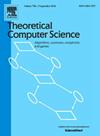关于繁忙的海狸边界的笔记
IF 1
4区 计算机科学
Q3 COMPUTER SCIENCE, THEORY & METHODS
引用次数: 0
摘要
我们研究了Radó(1962)提出的Busy Beaver博弈的几个变量之间的关系,例如空间(n)或num(n)函数,建立了这些函数的新边界,以及关于它们的一些性质。我们还在这类不可计算函数中引入并研究了一个新的函数,弹跳(n)。我们给出了弹跳(n)的一些具体值,以及关于它的增长及其与先前研究的Busy Beaver函数的关系的几个结果。我们还研究了这些函数的生长性质和关系,当考虑具有单个空白符号的非二进制字母的图灵机时。本文章由计算机程序翻译,如有差异,请以英文原文为准。
A note on busy beaver bounds
We investigate the relationship between several variations of the Busy Beaver game proposed by Radó (1962), such as the or the functions, establishing new bounds on these functions in terms of each other, as well as some properties about their growth. We also introduce and investigate a new function, , to this family of noncomputable functions. We give some specific values for , as well as several results concerning its growth and its relationship to the previously studied Busy Beaver functions. We also investigate growth properties and relationships of these functions when considering Turing Machines with non-binary alphabets with a single blank symbol.
求助全文
通过发布文献求助,成功后即可免费获取论文全文。
去求助
来源期刊

Theoretical Computer Science
工程技术-计算机:理论方法
CiteScore
2.60
自引率
18.20%
发文量
471
审稿时长
12.6 months
期刊介绍:
Theoretical Computer Science is mathematical and abstract in spirit, but it derives its motivation from practical and everyday computation. Its aim is to understand the nature of computation and, as a consequence of this understanding, provide more efficient methodologies. All papers introducing or studying mathematical, logic and formal concepts and methods are welcome, provided that their motivation is clearly drawn from the field of computing.
 求助内容:
求助内容: 应助结果提醒方式:
应助结果提醒方式:


